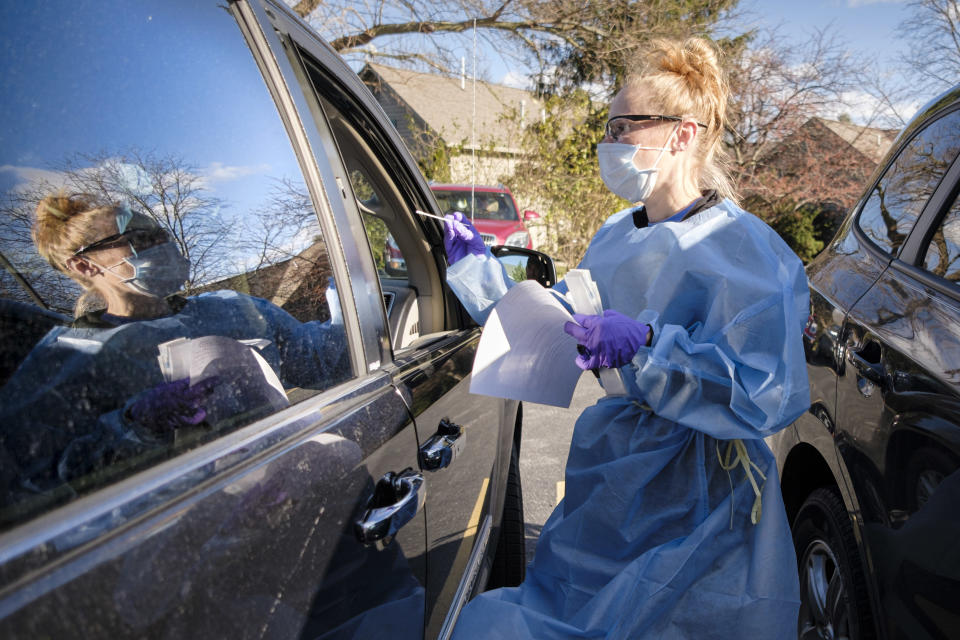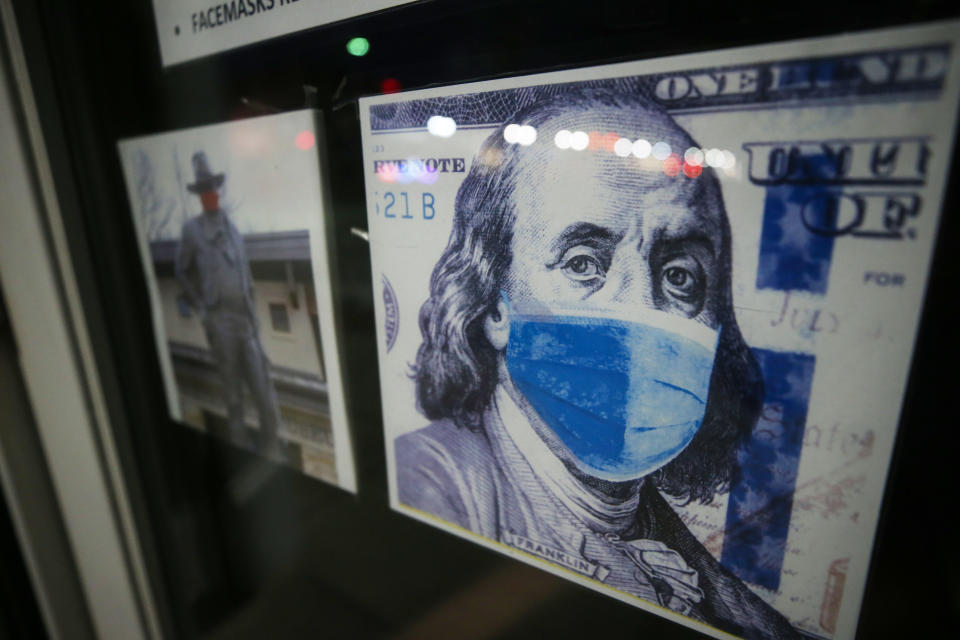Crushed by COVID-19, rural red states finally start to mandate masks. It may be too little, too late.
Earlier this week, Iowa’s Republican Gov. Kim Reynolds made national news when she reluctantly set aside her long-standing opposition to mask mandates and finally agreed to issue one in a state with a large rural population where COVID-19 is spreading at an "exponential and unyielding” rate.
“I don’t want to do this,” said Reynolds, who for months dismissed mask requirements as an unenforceable “feel-good” measure that she was “not going to” implement. “[But] if Iowans don’t buy into this, we lose. The cost in human life will be high.”
Reynolds’s abrupt reversal, which coincided with similar U-turns in Montana and North Dakota, was largely seen as a welcome sign that red states are now accepting what blue states (and scientists) have known since summer: Mandating masks leads to more mask wearing, and more mask wearing leads to less coronavirus.
According to a new study on the impact of St. Louis’s July 3 mask mandate, for instance, average daily COVID-19 case growth in that city three weeks after the ordinance went into effect was 44 percent lower than in neighboring counties where masks were not required. Twelve weeks later, case growth in St. Louis was still 40 percent lower.
Put another way, 13 of the 17 states currently struggling with the highest COVID-19 positivity rates are also states that don’t mandate masks or that just issued statewide mandates this month.
“The data shows that … when you put in a mask mandate, more than 80 percent of that specific population [starts] following it,” explained Dr. Enbal Shacham of St. Louis University, the lead author of the Missouri mask study. “It’s going to have a reduction.”

Yet Reynolds’s belated and begrudging order, while preferable to more stonewalling, also embodies the larger problem with rural America’s approach to masks. If you’re going to mandate them eventually — and there is no cheaper, easier and less intrusive way for a leader to combat COVID-19 than by encouraging people to mask up — then it makes sense to do it before things get really bad.
And make no mistake: Things in Iowa are really bad.
In that light, Iowa’s new mask mandate should serve as a warning to the rest of the country about how not to craft a mask mandate. Don’t riddle it with loopholes. Don’t undermine it with mixed messages. And most of all, don’t issue it only after hospitals — especially rural hospitals — start to reach capacity.
The statistics are stark. On Oct. 14, Iowa was averaging 1,100 new cases per day; one month later, that average had more than quadrupled to 4,703 new daily cases. But even this drastic spike vastly understates the true spread of the virus, because over the same period, the average percentage of Iowa tests coming back positive skyrocketed from (an already out-of-control) 20 percent to (a frankly terrifying) 51 percent.
More Iowans are dying as a result. If Iowa were a country, it would rank 28th in the world for daily deaths per capita from COVID-19, according to a Nov. 16 analysis by the Federation of American Scientists. One month ago, about 10 Iowans were dying from COVID-19 every day. Now the state seems to be setting new death records every 48 hours or so, with 41 deaths Tuesday and many more to come in the days and weeks ahead.

Why? Because deaths lag cases by about three weeks, which means that daily deaths in Iowa could exceed 100 early next month. To put that in perspective, it would represent a rate of 30 to 35 daily COVID-19 deaths per million residents — roughly two times the highest per capita death rate in the world right now. Already, a record 1,527 Iowans are hospitalized with COVID-19, up from a record 1,510 a day earlier. That’s double the number from two weeks ago. Coronavirus patients now make up one 1 of every 4 hospitalizations in the state.
When issuing her mask mandate earlier this week, Reynolds cited Iowa’s spiraling hospital crisis — the unsustainable strain on health care facilities, resources and staff — as the reason she changed her mind. Her “hand,” as the New York Times reported Tuesday, “was forced.”
“As pressure built from doctors, mayors and even people serving in [Reynolds’s] own administration, the message was clear: If she did not act, Iowa’s hospitals could soon be overflowing with coronavirus patients, leaving few ambulances, beds or doctors left to care for anyone else,” the paper explained.
But here’s the problem: It’s already too late for a mask mandate — particularly a half-hearted mask mandate like Reynolds’s — to keep Iowa’s hospitals from overflowing.
“We don’t have that many beds left,” Sioux City’s nonpartisan Mayor Bob Scott told the Times. “This should have happened three weeks ago.”
Or earlier. Mandating masks is a good way to help keep a COVID-19 outbreak under control. But if you wait until the outbreak is out of control to mandate face coverings — if you wait until your hand is forced — then you’re still going to be staring down weeks of baked-in infections, hospitalizations and deaths that could have been reduced or even prevented by a preexisting requirement.

This is doubly risky in the sort of red states that have resisted mask mandates the most. Small rural hospitals have been closing at a record pace due to a decline in elective procedures (and revenue) during the pandemic. The facilities that have managed to survive are often the last to upgrade their air-circulation systems and the first to run out of ventilators, PPE and available medical professionals. Patients are being airlifted out. Meanwhile, some rural hospitals, according to the Associated Press, are “converting chapels, cafeterias, waiting rooms, hallways, even a parking garage, into patient treatment areas. Staff members are desperately calling around to other medical centers in search of open beds. Fatigue and frustration are setting in among front-line workers.”
According to Eli Perencevich, an infectious disease doctor at the University of Iowa who spoke to the Atlantic’s Ed Yong, the state has already run out of staffed beds.
“The wave hasn’t even crashed down on us yet,” Perencevich predicted. “It keeps rising and rising, and we’re all running on fear. The health care system in Iowa is going to collapse, no question.”
Needless to say, this is not an optimal environment for saving lives, which arguably makes routine mask wearing even more consequential in rural America than in places with sturdier medical systems (and presumably less burdensome, too, assuming lower population density means fewer close interactions with people from other households).

In Iowa, the best-case scenario is that residents cooperate with Reynolds’s mask mandate and cases start to decline in a few weeks, eventually easing the crush on hospitals. But there’s reason to worry that won’t happen. Part of it is seasonal: Frigid temperatures and holiday celebrations will increasingly tempt people to gather indoors. Part of it is political: Polls show that Republicans are far more hostile to masks than Democrats, and Iowa is a red state where leaders like Reynolds have long framed universal masking as somehow inconsistent with personal liberty.
But the most disturbing and avoidable factor is poor policy. According to Reynolds’s mandate, Iowans must wear a mask in indoor public places — but only if they will be within 6 feet of someone from outside their household for at least 15 minutes. And so “if you’re standing 6 feet apart in a grocery line where the wait is 12 minutes, you aren’t required to wear a mask,” Des Moines Register columnist Rekha Basu noted Tuesday. “And the mask rule doesn’t apply to bars and restaurants — or religious services. Eateries and drinking holes can stay open 16 hours straight, to 10 p.m.” In fact, indoor dining is still permitted. And school districts are allowed to decide for themselves whether to mandate masks; about one-third of Iowa’s school districts currently do not require them.
A policy that porous may not be powerful enough to counter Iowa’s significant seasonal and political headwinds. And it doesn’t help that Reynolds, speaking Tuesday, is still saying, “There’s science on both sides” about masks, and “If you look, you can find whatever you want to support wherever you’re at.” (The science actually says that “universal masking policies can help avert future lockdowns.”)
On Thursday, President-elect Joe Biden discussed a possible nationwide mask mandate during a call with Republican and Democratic governors, declaring afterward that covering your face is “not a political statement” but rather “a patriotic duty.” His team is also exploring ways to persuade resistant Republican governors to get on board, including possibly tying federal COVID-19 relief to statewide mandates.

But any national progress will have to wait until Biden takes office on Jan. 20. Before then, Reynolds may be a better model than, say, South Dakota Gov. Kristi Noem, who on Thursday refused to encourage her constituents to wear masks or socially distance, saying those who go maskless are making a “personal decision” and deserve respect — despite the fact that COVID-19 cases and deaths are rising even faster in her state than in Iowa.
But an even better model on masking would be California, which first mandated masks in public areas and other high-risk settings five months ago and earlier this week expanded that requirement to any outdoor setting within 6 feet of people from other households. The first mandate went into effect when 4.6 percent of California’s COVID-19 tests were coming back positive; today the state’s positivity rate is only slightly higher (5.2 percent) and hospitals seem to have sufficient capacity to handle the winter surge.
Here’s hoping it stays that way — and that the rest of America realizes sooner rather than later that following California’s lead on masks is smarter than following Iowa’s.
_____
Read more from Yahoo News:

 Yahoo Finance
Yahoo Finance 


